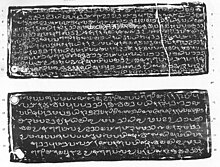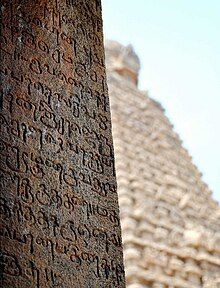Vatteluttu
| Vattezhutthu | |
|---|---|
 Vatteluttu in Tharisapalli Copper Plates. | |
| Script type | |
Time period | BCE 3200–present |
| Direction | Left-to-right |
| Languages | Tamil |
| Related scripts | |
Parent systems | |
Child systems | Saurashtra |
Sister systems | Malayalam, Grantha, Kolezhuthu, Malayanma |
[a] The Semitic origin of the Brahmic scripts is not universally agreed upon. | |
Template:IndicText The Vaṭṭeḻuttu alphabet, also spelled Vattezhutthu (literally "rounded script", Template:Lang-ta, vaṭṭeḻuttu, Tamil pronunciation: [ʋəʈːeɻʉt̪ːʉ]; Malayalam: വട്ടെഴുത്ത് vaṭṭeḻuttŭ) is an abugida writing system originating from the ancient Tamil people of South India. Developed from Tamil-Brahmi, Vatteluttu is one of the three main alphabet systems developed by Tamil people to write the Proto-Tamil language, alongside the ancient Grantha or Pallava alphabet and the Tamil script. The syllabic alphabet is attested from the 6th century CE to the 14th century in present-day Tamil Nadu and Kerala states of India.[1] It was later supplanted by modern Tamil script and Malayalam script. Vaṭṭeḻuttu replaced Tamil-Brahmi for writing Tamil after the 2nd century CE. This rounded form of writing was also used in Kerala to write in Tamil as well as in proto-Malayalam and Malayalam language. Currently, Malayalam uses the Malayalam script. Inhabitants of Kuccaveli, located north of Trincomalee, used the Vaṭṭeḻuttu script between the 5th and 8th centuries, attested to on rock inscriptions found there.[1] Inscriptional records in Tamil date from 300 BCE to 1800.[2] Grantha was an alphabet in which extra letters were created specifically for Sanskrit words. It was also a modified form of Tamil script to write Sanskrit granthas or books. In Tamil, many of the letters which are found in Sanskrit do not exist.
Samples

The following image shows the divergent evolution of the Tamil script and the Vatteluttu script. The Vatteluttu script is shown on the left, and the Tamil script is shown on the right.

Here are the characters used in Vatteluttu:

See also
- Tamil copper-plate inscriptions
- Indian copper plate inscriptions
- Laguna Copperplate Inscription
- Pallava script
- Tamil script
Bibliography
- Sivaramamurti, C, Indian Epigraphy and South Indian Scripts. Bulletin of the Madras Government Museum. Chennai 1999
